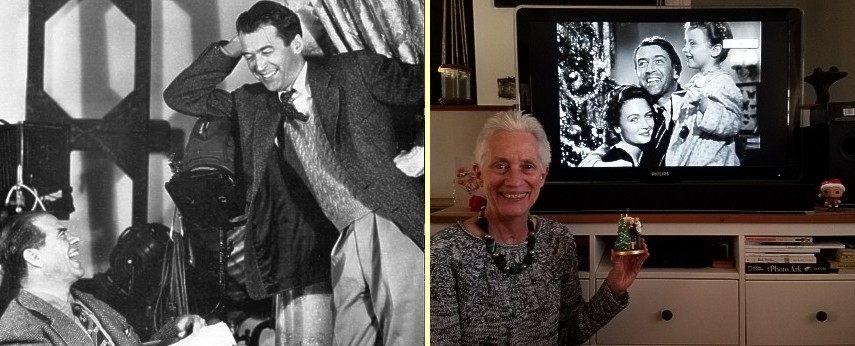Kansas Snapshots by Gloria Freeland - December 24, 2021
Christmas classic turns 75
When Irving Berlin wrote "White Christmas," he wasn't convinced the song was worthy of publication. "Rudolph the Red Nosed
Reindeer" was written for a small give-away booklet that Montgomery Ward hoped would entice shoppers into the company's
department stores. When the related song was composed, singer Gene Autry needed his wife’s coaxing to record it. These are
now Christmas staples, yet seemed unlikely by those closest to them to enjoy anything more than some small success.
When husband Art showed me an article by Jenny Ashcraft from newspapers.com about one of my favorite Christmas movies, it
inspired some additional research. It too revealed a holiday effort likely destined for little success. The movie - "It's
a Wonderful Life" - was released in New York City 75 years ago this past Monday. It received mixed reviews.
The story, originally titled "The Greatest Gift," was written by Philip Van Doren Stern, a Rutgers-educated fellow who, like
"Rudolph" author Robert May, began his career in advertising. He later became a respected writer of Civil War history, but
his 1939 effort at fiction was rebuffed by all the publishers he approached. Frustrated, in 1943, he printed it himself and
sent copies to friends as a sort of Christmas greeting.
David Hempstead of RKO Studios saw a copy and purchased the film rights, seeing it as a vehicle for studio star Cary Grant.
Grant, who always projected a sophisticated, educated air about him, seemed nothing like Stern's main character, George Pratt,
later renamed George Bailey.
Bailey runs a small bank that helps ordinary people, while Henry Potter, the story's villain, tries to take over the town. A
mistake at the bank makes it appear Potter will win. Bailey wishes he had never been born until an angel shows him what the
village and its people would have been like without him.
RKO never made the movie and the rights were bought by Frank Capra as World War II came to an end. Capra, a highly successful
director and producer, had lived a life that could have formed the basis for a movie. Born in Italy, he became the
personification of the American dream. His "Why We Fight" series created for the government often was filmed during actual
battles and was a major morale booster on the home front.
Capra recognized George Bailey as the American "everyman" during peacetime, just as Capra's war-time films focused on average
Americans on the battlefield. He had previously made several movies with Jimmy Stewart - the actor people had come to see as
best exemplifying this "everyman."
But there were problems. Many Hollywood stars who joined the service were placed in units that entertained the troops. But
Stewart didn’t seek an exemption and was in the first group drafted. He became a B-24 co-pilot and his 445th bomb group
stationed at Tibbenham, England, was one of the earliest American units to fly over Germany. On one mission in Bavaria,
anti-aircraft fire punched a two-foot hole in the plane, just inches from Stewart's boot. He and pilot Neil Johnson could
look through the bottom of the craft and see Germany below!
Stewart entered service as a private and was a colonel by its end, frequently serving as wing commander during missions. But
episodes such as the one previously mentioned left Stewart with Post Traumatic Stress Disorder, which limited his flying time
to 20 missions.
After the war, MGM, which had Stewart under contract, wanted to capitalize on this real war-time hero by featuring him in films
about the war. But Stewart refused, feeling it was inappropriate. His stand resulted in his being fired. And the years of
stress had aged Stewart, so he no longer had the boyish look of his prewar years. He worried his movie-making days might be
over.
But Capra thought the Bailey part was a perfect fit for Stewart. Today, it would be hard to imagine any other actor in that
part.
Yet even with both an A-list leading man and an equally-respected Capra at the helm, the movie did poorly at the box office.
With the war over, people were ready to celebrate and theaters were jammed with good films, such as "The Harvey Girls" with
Judy Garland, "The Big Sleep" with Humphrey Bogart and Lauren Bacall, and an abundance of Westerns, such as "Duel in the Sun,"
with Joseph Cotten and Gregory Peck. These were just a few of the films released in 1946. Stewart later said, "Our movie just got lost."
Ashcraft’s article described what changed the film's fate:
In 1974, the copyright for the movie lapsed, allowing television stations to broadcast it at no cost. A whole new generation
discovered the film, and its popularity soared. More than 80,000 people purchased a videocassette copy of the movie in 1986.
In 1987, that number nearly doubled. Watching the film became a Christmas tradition for many American families.
While "White Christmas," the Rudolph story and the song were almost immediately big hits, "It's a Wonderful Life" wasn't taken
into the nation's heart until almost 30 years after its release. My family was one of those, watching the film almost every
Christmas.
After the war, Stewart joined the Air Force Reserves, eventually retiring as a general. His movie career was a long one, and late
in life he said "It's a Wonderful Life" was his favorite film. He and Frank Capra were close friends until Capra's passing in
1991. Stewart died in 1997.
This tale began with a historian's attempt to show the impact one life can have. But whether a life, a film or anything else,
sometimes the effect is not immediate. Some require time to develop.
Merry Christmas everyone, and Happy 75th birthday to a favorite film!
